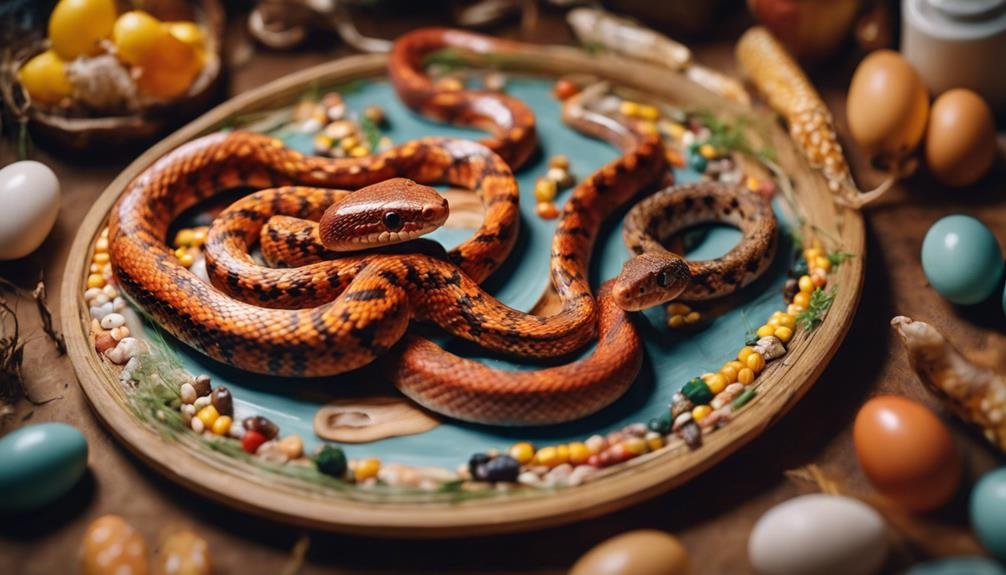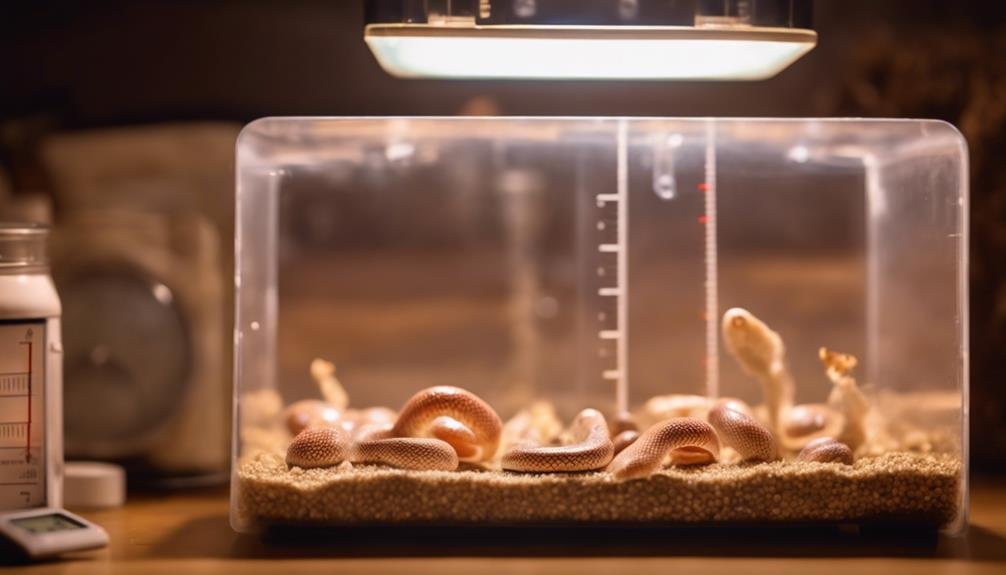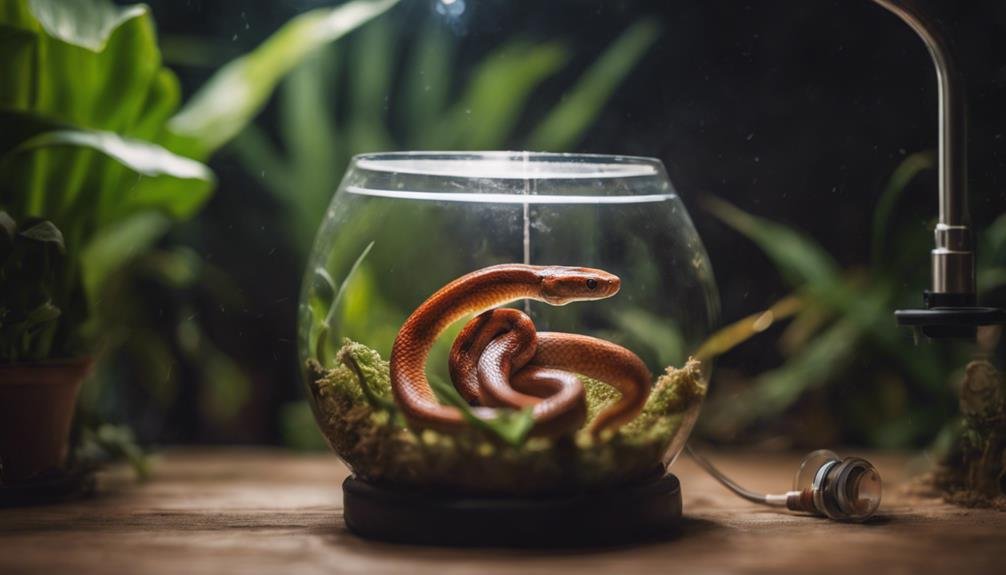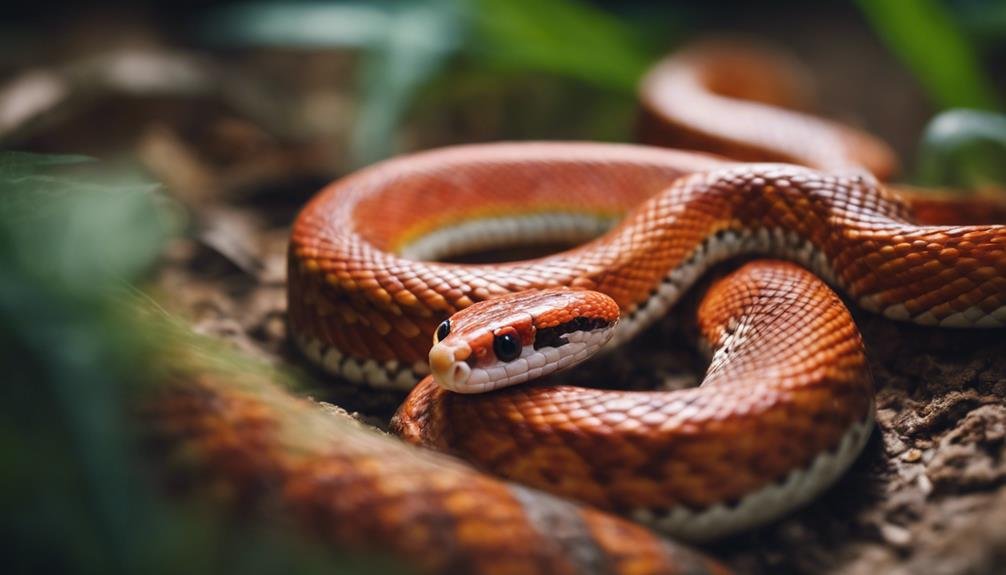You’re entering the nuanced world of breeding corn snakes without the traditional period of brumation, a task that requires a keen understanding of their needs and behaviors. Adjusting their environment to mimic the natural triggers for mating without lowering their temperatures for a dormant period challenges many breeders’ understanding of reptile husbandry. By focusing on temperature control, light cycles, and dietary adjustments, you’re not just attempting to replicate nature but also ensuring the health and fertility of your snakes. This approach opens up a dialogue on the adaptability and resilience of corn snakes, but how does it compare to traditional methods, and what unique challenges might you face? Let’s explore the intricacies and potential benefits of this non-traditional breeding method.
Key Takeaways
- Adjust ambient temperatures to stimulate mating behavior without the need for a cooling period.
- Monitor and manage feeding routines to ensure snakes are nutritionally prepared for breeding.
- Provide a temperature gradient and proper humidity to mimic natural breeding conditions.
- Engage with community insights for non-brumation cues and techniques to enhance mating success.
- Ensure both male and female snakes are mature and in optimal health for breeding without brumation.
Understanding Corn Snake Breeding
To successfully breed corn snakes without the traditional brumation period, you’ll need to carefully manage temperatures and feeding routines. Adjusting these factors appropriately can mimic the seasonal changes corn snakes would naturally experience, encouraging them to enter a breeding state. You’ll find that introducing the male to the female after these adjustments can greatly trigger breeding behavior. This method demands a keen observation of your snakes’ conditions and an understanding of their needs.
Age plays a pivotal role in this process. Typically, males are ready to breed around 3 years old, while females must be fully mature to guarantee healthy egg production. This maturity is essential for maintaining high fertility rates, as immature females may produce fewer eggs or eggs of inferior quality.
Moreover, the foundation of successful breeding lies in proper nutrition and the monitoring of reproductive cycles. Ensuring your snakes are well-fed with a diet rich in the necessary nutrients is important for their health and the vitality of their offspring. Additionally, paying close attention to genetic diversity when selecting breeding pairs not only prevents health issues but can also enhance fertility rates, leading to a more successful breeding season without the need for brumation.
Optimal Environmental Conditions
To guarantee your corn snakes are ready for breeding without the need for brumation, you’ll need to pay close attention to temperature control methods and humidity management techniques.
Maintaining a precise temperature range and a consistent humidity level in their enclosure is key to mimicking their natural breeding conditions.
Let’s explore how you can effectively manage these environmental parameters to promote healthy breeding behaviors in your corn snakes.
Temperature Control Methods
For successful breeding of corn snakes without brumation, it’s essential you maintain daytime temperatures around 80-85°F and allow a slight drop at night to 70-75°F. This approach guarantees your corn snakes are comfortable and healthy, even if they’ve never brumated.
To achieve this, provide a thermal gradient across the enclosure by setting up a heat source on one side. This allows your snakes to regulate their body temperature by moving between warmer and cooler areas.
It’s vital to use a thermostat to monitor and maintain these temperatures consistently, preventing any risk of overheating. A well-managed temperature regime not only supports the breeding cycle but also mimics the natural conditions your corn snakes would experience in the wild, fostering a conducive environment for reproduction without the need for brumation.
Humidity Management Techniques
Maintaining ideal humidity levels, essential for egg development, requires careful monitoring between 40-60% using a reliable hygrometer. You should never underestimate the importance of this step.
Utilizing a moist substrate such as vermiculite or perlite will assist in keeping the humidity at the desired levels. However, it’s critical to balance this moisture with proper ventilation in the incubation container. Too much moisture can lead to mold growth, which is detrimental to the eggs. Ensuring that there’s enough airflow to prevent excess moisture from building up is key.
Consistent humidity is non-negotiable for healthy embryo development. Paying close attention to these details is crucial for the successful breeding of corn snakes without brumation.
Diet and Nutrition for Breeding


When breeding corn snakes, you should adjust their diet to include weekly or every 5-day feedings to support their health and energy levels. This is especially important if you’re working with specific morphs, such as anery het, as their wellbeing directly impacts the success and quality of the offspring. Ensuring they receive a well-balanced diet, rich in essential nutrients, is key. Consider dusting their meals with calcium and multivitamins to cover any nutritional gaps that might exist, even more so during this demanding period.
Monitoring is crucial; an increase in the female’s appetite can signal gravidity, indicating it’s time to adjust feeding frequency and portion sizes. This change isn’t just about quantity but also quality, ensuring every meal contributes to her overall health and the development of the eggs. Changes in feeding behavior often reflect reproductive activity, requiring you to be observant and ready to adapt the diet as needed.
It’s essential to tailor the feeding regimen to the individual snake, taking cues from their behavior. When in doubt, consulting with a reptile veterinarian can provide specialized advice, helping you navigate the diet and nutrition aspects of breeding corn snakes without brumation effectively.
Stimulating Mating Behavior
You’ve adjusted their diet and made sure they’re nutritionally prepared, but there’s more you can do to encourage your corn snakes to mate without brumation.
Enhancing Natural Mating Cues
To stimulate natural mating behavior in corn snakes without resorting to brumation, you can adjust temperature and light cycles. After making these adjustments, introducing the male to the female can greatly trigger mating cues and behaviors. But, how do you know you’re doing it right? Engaging with a forum community can offer invaluable insights and shared experiences to guide you through these adjustments.
| Cue | Effect on Mating Behavior |
|---|---|
| Temperature Adjustments | Mimics seasonal changes, encouraging breeding |
| Introducing the Male | Triggers female receptivity and mating cues |
| Light Cycle Changes | Stimulates natural breeding cycles |
| Monitoring Behavior | Indicates female readiness without brumation |
Creating a simulated natural environment enhances the likelihood of successful mating. Remember, patience and observation are key to understanding and optimizing these cues for your corn snakes.
Temperature Fluctuations and Mating
Building on the importance of environmental cues, adjusting temperature fluctuations plays a significant role in stimulating mating behavior in corn snakes. By slightly altering the ambient temperature in their enclosure, you can trigger breeding responses in both males and females.
This method involves creating a temperature gradient to mimic natural seasonal changes, which encourages mating behavior. Such temperature shifts can influence hormonal changes within the snakes, promoting courtship and subsequent mating activities.
It’s essential to monitor these changes closely to replicate natural breeding conditions effectively, enhancing reproductive success. By carefully managing temperature fluctuations, you can stimulate mating behavior in corn snakes without the need for brumation, ensuring a successful breeding season.
Managing Egg Incubation


Once your corn snake lays her eggs, managing the incubation process with precision is important to guarantee healthy hatchlings. Egg incubation for corn snakes is a vital step that demands close attention to temperature, humidity, and the overall condition of the eggs. Achieving the right environment for your eggs will make all the difference in ensuring they develop properly over the approximate 60-day incubation period.
To nail down the egg incubation process, consider the following key points:
- Maintain Ideal Temperature and Humidity: Ensure the incubation environment is consistently between 80-83°F (26.6-28.3°C) and maintains a relative humidity level of 75-80%. Fluctuations outside these ranges can negatively impact embryo development.
- Regularly Candle the Eggs: This non-invasive technique allows you to monitor the growth and health of the embryos inside the eggs. By shining a light through each egg, you can observe its development stages and detect any potential issues early on.
- Ensure Proper Ventilation: Good airflow is pivotal in preventing mold growth, which can be detrimental to the eggs. However, balance is key, as too much airflow can lower humidity levels below the ideal range.
Post-Hatching Care
After guaranteeing your corn snake eggs hatch successfully, it’s important to focus on the care of the newborns to promote their health and development. Post-hatching care is vital in setting the foundation for a healthy life for these little reptiles.
Right off the bat, you’ll want to house each baby corn snake individually. This prevents any chance of cannibalism, a real threat among these creatures at such a tender age.
Next up, make sure to provide a small, secure hiding spot in each enclosure. This simple step significantly reduces stress, aiding in their proper development. When it comes to feeding, offer pinky mice that are appropriately sized for your newborn corn snakes. This ensures they’re getting the nutrition they need without the risk of injury.
Maintaining a warm and humid environment is also essential to their growth and digestion post-hatching. Regular checks on their health, eating habits, and shedding process allow you to catch any issues early on. By closely monitoring these aspects, you’re setting your baby corn snakes on the right path towards a healthy and vibrant life.
Common Challenges and Solutions


Breeding corn snakes without brumation presents unique challenges, but understanding and addressing them can lead to successful outcomes. You’re choosing to skip the cooling period, which means you’ll need to pay extra attention to several key factors to encourage your male and female corn snakes to mate successfully.
Here are the top three challenges you’ll face and how you can solve them:
- Adjusting Temperatures Appropriately: Without the natural cue of brumation, you’ll need to carefully adjust the temperatures to mimic seasonal changes. This involves gradually increasing the temperature to stimulate the breeding cycle, especially before introducing the male to the female.
- Ensuring Maturity and Health: It’s essential that both the male and female are fully mature and in excellent health. Males are typically ready around 3 years old, while females need to be fully mature. Proper nutrition and monitoring of their reproductive cycles become even more vital without brumation.
- Managing High Metabolism: Without the cooling period, your snakes will maintain a higher metabolism year-round. This requires close monitoring to make sure they’re not under undue stress, which could affect breeding success. Paying attention to their dietary needs and adjusting husbandry practices accordingly can mitigate potential issues.
Can Corn Snakes Successfully Breed Without Brumation?
Yes, corn snakes can successfully breed without brumation. However, if you are hoping to breed your corn snakes, it is important to understand the incubating corn snake eggs process. Proper temperature and humidity levels are crucial for successful egg development and hatching.
Conclusion
To sum up, you have the power to breed corn snakes without the need for brumation by closely managing their environment, diet, and behavior. By adjusting temperatures, mimicking natural light cycles, and ensuring they’re well-fed, you’ll encourage mating.
Keep a close eye on egg incubation and provide tender care post-hatching to tackle common challenges head-on. With patience and attention to detail, you’ll navigate the breeding process successfully, leading to healthy and vibrant hatchlings.
Remember, it’s all about creating the perfect conditions and staying observant.


